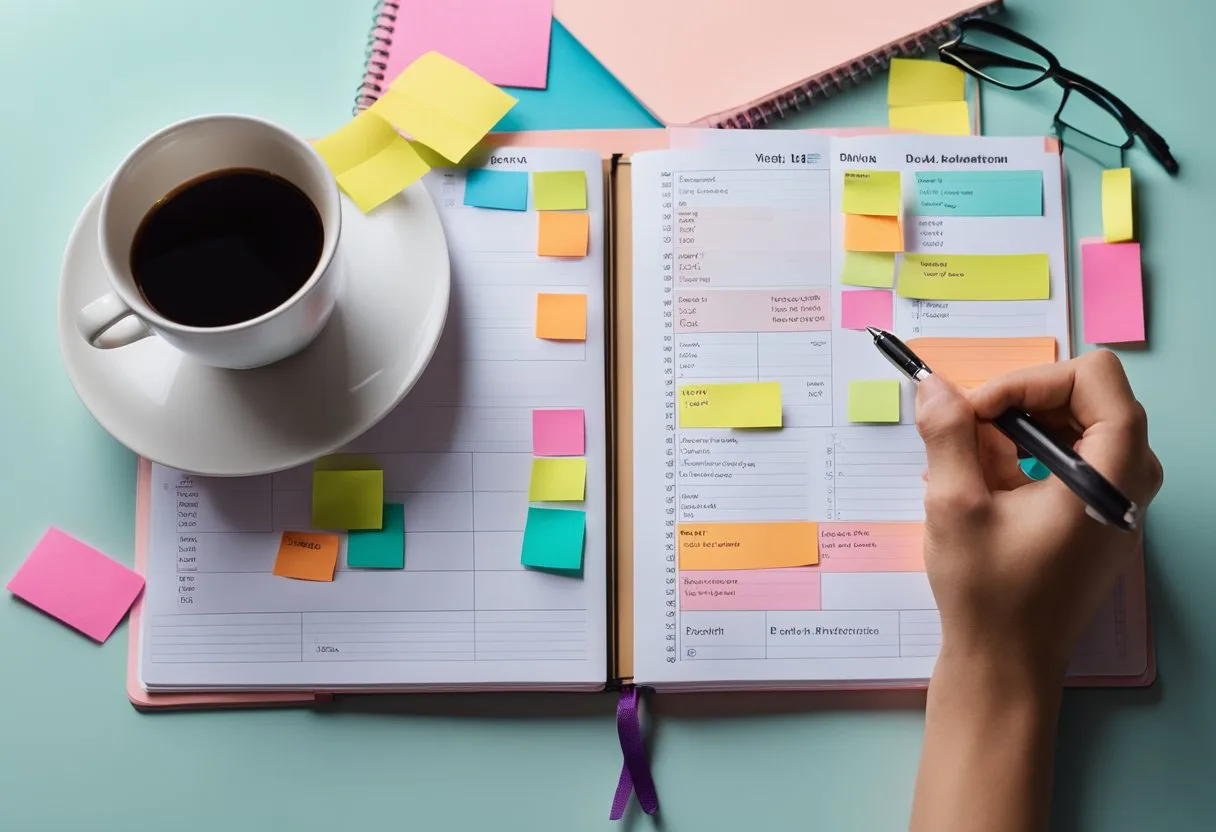Effective call planning is crucial for sales representatives to achieve success. However, it is often overlooked. In a survey conducted by HubSpot, 82% of B2B decision-makers believed that sales representatives were unprepared before engaging in a sales call. This shows that there is a need for sales representatives to improve their call planning skills. In this blog post, I will share with you 25 call planner ideas to boost your productivity and increase effeciency.
One way to improve call planning is to use planner ideas. These ideas help sales representatives set goals, focus on their tasks, and stay organized. With proper planning, sales representatives can balance their workload and achieve their targets efficiently. In this article, we will explore some call planner ideas that can help sales representatives plan their calls effectively.
Choosing the Right Planner
A call planner is an essential tool for salespeople to maximize their effectiveness during sales calls. Choosing the right planner is crucial to ensure that the salesperson is comfortable with the planner’s style, content, and customization options. There are several types of planners available in the market, including digital planners, paper planners, and hybrid planners. Each type of planner has its advantages and disadvantages.
For example, digital planners are more convenient to use, while paper planners provide a more tangible and personalized experience. Ultimately, the salesperson should choose a planner that suits their needs, preferences, and work style.
Sales Call Plan Structure
A sales call plan is a structured approach to sales calls that helps salespeople be better prepared, confident, and focused. The sales call plan structure should include the following elements:
- Pre-call research: Researching the prospect’s business, industry, and pain points before the call.
- Objectives: Defining the objectives of the call, such as introducing a new product, scheduling a follow-up call, or closing a deal.
- Agenda: Preparing an agenda for the call that outlines the topics to be discussed and the time allocated for each topic.
- Questions: Preparing a list of open-ended questions to ask the prospect during the call to gather information and build rapport.
- Objections: Anticipating objections that the prospect might raise and preparing responses to overcome them.
- Next steps: Defining the next steps after the call, such as sending a follow-up email, scheduling a demo, or closing a deal.
A call planner is an essential tool for salespeople to maximize their effectiveness during sales calls. The salesperson should choose a planner that suits their needs, preferences, and work style. The sales call plan structure should include pre-call research, objectives, agenda, questions, objections, and next steps.
Planner Organizational Strategies

When it comes to call planning, being organized is key to success. Here are a few organizational strategies that can help:
Time Management Techniques
Time management techniques are essential when it comes to call planning. One effective technique is to create a checklist of tasks that need to be completed before the call. This can help ensure that everything is done in a timely manner and nothing is forgotten. Another technique is to break down larger tasks into smaller, more manageable ones. This can help prevent overwhelm and make the call planning process more manageable.
Prioritizing Tasks
Prioritizing tasks is another important organizational strategy. It’s important to identify the most important tasks and prioritize them accordingly. This can help ensure that the most important tasks are completed first and that nothing falls through the cracks. One effective way to prioritize tasks is to use a to-do list. This can help keep everything organized and ensure that nothing is forgotten.
Being organized is key when it comes to call planning. By using time management techniques and prioritizing tasks, call planners can ensure that everything is done in a timely manner and that nothing is forgotten.
Enhancing Sales Performance
To improve sales performance, it is essential to have a well-planned sales strategy. Sales professionals must be able to identify potential customers and engage them effectively to close deals. Here are some tips to enhance sales performance:
Prospecting and Research
Prospecting is the first step in the sales cycle. Sales professionals must identify potential customers who are likely to be interested in their products or services. Conducting thorough research about the prospect can help sales professionals to understand their needs, preferences, and budget. This information can be used to tailor the sales pitch and offer a solution that meets the prospect’s requirements.
Sales professionals can use CRM tools to keep track of their prospects and their interactions with them. By maintaining a record of all the communication, sales professionals can identify the best time to follow up and close the deal.
Tracking Sales Metrics
Sales metrics are essential to measure the effectiveness of the sales strategy. Sales professionals must track their progress towards their quotas and identify areas that need improvement. By tracking the sales metrics, sales professionals can identify the best practices that lead to successful deals and replicate them.
Sales professionals can use a variety of metrics to track their performance, including the number of calls made, the number of meetings scheduled, and the number of deals closed. By analyzing these metrics, sales professionals can identify the bottlenecks in the sales process and take corrective action.
Enhancing sales performance requires a combination of effective prospecting, research, and tracking of sales metrics. By following these tips, sales professionals can improve their sales strategy and close more deals.
25 Call Planner Ideas
- Daily call schedule with time slots
- Prospective client call list
- Follow-up call reminders
- Weekly call objectives
- Client contact information section
- Call outcome notes and action steps
- Monthly call volume tracker
- Lead qualification checklist
- Script prompts for sales calls
- Customer service issue resolution log
- Call priority levels
- Conference call agendas
- Call duration log for billing purposes
- Cold call tracking and statistics
- Post-call reflection and improvement notes
- Voicemail follow-up reminders
- Call delegation and team member assignments
- New leads contact schedule
- Client retention call planner
- Quarterly call analysis for strategy planning
- Call-related expense tracker
- Cross-reference list for calls and emails
- Call coaching and training progress
- Time zone converter for international calls
- End-of-week call summary and review
Planner Personalization and Customization

Personalization and customization are essential elements when it comes to designing a planner. These elements allow individuals to create a planner that is unique and tailored to their specific needs and preferences. There are various ways to personalize and customize a planner, including decorative elements and functional add-ons.
Decorative Elements
Decorative elements can add a touch of personality to a planner. Some popular decorative elements include covers, stickers, washi tape, and sticker books. Covers come in different designs and materials, and individuals can choose one that reflects their personality or interests.
Stickers and washi tape can be used to add color and design to a planner and can be used to highlight important dates or events. Sticker books are also a great way to add variety to a planner, with different themes and designs to choose from.
Functional Add-Ons
Functional add-ons are elements that can improve the functionality of a planner. Habit trackers, bucket lists, and customizable pages are popular functional add-ons. Habit trackers can help individuals keep track of their daily habits, while bucket lists can help them set and achieve long-term goals. Customizable pages allow individuals to create pages that are specific to their needs, such as financial pages, contacts, and year-end carry-over pages.
Personalization and customization are essential when it comes to designing a planner. Decorative elements such as covers, stickers, washi tape, and sticker books can add personality to a planner, while functional add-ons such as habit trackers, bucket lists, and customizable pages can improve its functionality.
Health and Well-Being Integration
Maintaining a healthy lifestyle is crucial for any call center agent’s well-being. Incorporating exercise and diet, stress management, and self-care practices can help improve an agent’s overall health and productivity.
Incorporating Exercise and Diet
Call center agents spend a significant amount of time sitting down, which can lead to a sedentary lifestyle and health problems such as obesity, diabetes, and heart disease. Encouraging agents to take breaks and move around can help alleviate these issues.
Providing healthy snacks and drinks, such as water, fruits, and nuts, can also help agents maintain a healthy diet. A well-balanced diet can help boost energy levels, improve mood, and enhance cognitive function.
Stress Management and Self-Care
Working in a call center can be stressful, leading to burnout and other mental health issues. Providing stress management resources, such as counseling and meditation sessions, can help agents cope with work-related stress.
Encouraging agents to practice self-care, such as taking breaks, practicing gratitude, and keeping a growth tracker, can also help improve their mental health. Practicing self-care can help agents recharge, improve their mood, and increase their productivity.
Incorporating health and well-being practices into a call center’s culture can help improve agent productivity and overall well-being. Providing resources for exercise and diet, stress management, and self-care can help agents maintain a healthy lifestyle and cope with work-related stress.
Frequently Asked Questions

How can one effectively organize daily work calls using a planner?
To organize daily work calls using a planner, one should first identify the specific tasks and goals that need to be accomplished. Then, they can schedule their calls and meetings around those tasks, ensuring that they have enough time to complete each task. It is also important to prioritize tasks and calls based on their urgency and importance. By doing so, one can ensure that they are making the most of their time and staying on track with their work.
What are the essential elements to include in a weekly work planner?
A weekly work planner should include the following essential elements:
- A list of tasks and goals for the week
- A schedule of calls and meetings
- Deadlines for each task
- Prioritization of tasks and calls
- Notes and reminders for each task
What are the key features to look for in a digital planner for professional use?
When selecting a digital planner for professional use, it is important to look for the following key features:
- Compatibility with multiple devices
- Integration with other productivity tools
- Customization options
- Easy-to-use interface
- Security features to protect sensitive information
What strategies can be employed to optimize meeting planning?
To optimize meeting planning, one should:
- Set a clear agenda and stick to it
- Invite only necessary attendees
- Schedule meetings during non-peak hours
- Use technology to streamline the process
- Follow up with action items and deadlines
How can a planner be customized to enhance productivity for calls and meetings?
To customize a planner for calls and meetings, one should:
- Include specific details about each call or meeting, such as the purpose, attendees, and agenda
- Schedule calls and meetings during non-peak hours to avoid interruptions
- Use color coding and labels to differentiate between different types of calls and meetings
- Prioritize calls and meetings based on their importance and urgency
- Set reminders and follow-up tasks to ensure that nothing falls through the cracks
What are the best practices for maintaining a planner to manage work-related tasks?
The best practices for maintaining a planner to manage work-related tasks include:
- Regularly updating the planner with new tasks and deadlines
- Reviewing the planner at the beginning and end of each day to ensure that all tasks are completed
- Prioritizing tasks based on their urgency and importance
- Keeping the planner organized and easy to read
- Using the planner as a tool for time management and productivity




